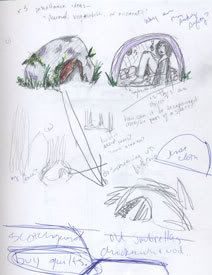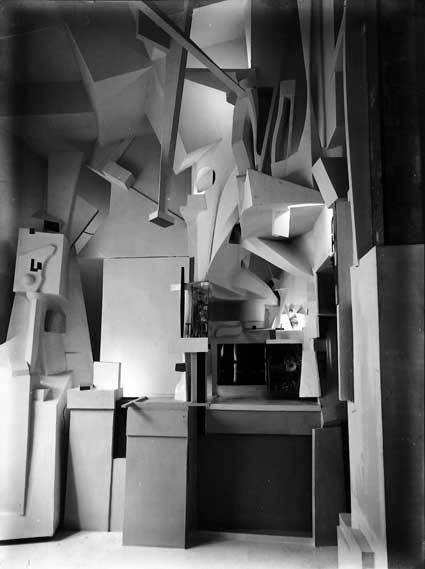On Friday, April 7th, I attended a showing of The Mandrake. At it was written by Nicolo Machiavelli, political theorist who also wrote The Prince, one could take its message to be a political one. (It probably is.)
It was an enjoyable production, with lots of humor. Very funny. I really liked it. I liked how the introduction was set up as a band of travelling players unpacking and parading, especially the trapdoor gag where cast members take out their costumes, and then a signpost, and then the musicians.
Saturday, April 21, 2007
Monday, April 2, 2007
Art event: Visit to the Walters Art Museum
Over spring break, I visited the Walters Art Museum in order to see Untamed: The Art of Antoine-Louis Barye.
Barye lived between 1796 and 1875, and is most well known for his bronze sculptures of animals. Most of the animals in his sculptures are in action in some way-- most often hunting or being hunted. There were tiger hunts, there were lion hunts, there were stag hunts, there were bear hunts. There were bears attacking stags, dogs attacking bears, tigers attacking crocodiles, and snakes attacking tigers.
They were all variations on a theme, to say the least.
He was very good at what he did: in the hunting scenes, riders often look like they're about to fall off their horses. He was excellent at capturing motion and action.
What was very interesting to me was that they also displayed a variety of his paintings, in oil and watercolors, which were, to me at least, sweeter. It was a very nice break from all the man vs. nature captured in bronze. The paintings still always involved animals, but it was more likely that it was a lion trotting along a path, or a tiger rolling around on its back. However, Barye never really left France, never really got to see these exotic animals in their natural habitats. He studied and sketched them at the Jardin des Plantes, and so often wound up painting a lion trotting along a path... in the French countryside.
In fact, I attended this exhibit with my mother, and when we saw the lion tortting along the path in the French countryside painting, she exclaimed, "Someone better call the zoo, quick! That lion's escaped!" She didn't even need to read the wall text to see that the lion was out of place.
Barye lived between 1796 and 1875, and is most well known for his bronze sculptures of animals. Most of the animals in his sculptures are in action in some way-- most often hunting or being hunted. There were tiger hunts, there were lion hunts, there were stag hunts, there were bear hunts. There were bears attacking stags, dogs attacking bears, tigers attacking crocodiles, and snakes attacking tigers.
They were all variations on a theme, to say the least.
He was very good at what he did: in the hunting scenes, riders often look like they're about to fall off their horses. He was excellent at capturing motion and action.
What was very interesting to me was that they also displayed a variety of his paintings, in oil and watercolors, which were, to me at least, sweeter. It was a very nice break from all the man vs. nature captured in bronze. The paintings still always involved animals, but it was more likely that it was a lion trotting along a path, or a tiger rolling around on its back. However, Barye never really left France, never really got to see these exotic animals in their natural habitats. He studied and sketched them at the Jardin des Plantes, and so often wound up painting a lion trotting along a path... in the French countryside.
In fact, I attended this exhibit with my mother, and when we saw the lion tortting along the path in the French countryside painting, she exclaimed, "Someone better call the zoo, quick! That lion's escaped!" She didn't even need to read the wall text to see that the lion was out of place.
Installation proposal
Edit: Some things have changed, in connection with this project.
The den will most likely be quilts over a wire frame, the outside treated (with paint?) to look like rock and dirt, evoking animal-made safe space. The inside will still be quilts, evoking human-made safe space.
Sketches:

(click for big!)
What is still up in the air is the speakers idea.
My main idea is to create an animal den, something that the viewer/participant has to crawl into (or otherwise change their body shape in which to enter).
The den will be created to be a safe space, as it will have one entrance/exit. It will also incorporate more than one sense in that it will be more of an experience than just looking at something. One can look at it, but one can also enter it, and the experience will be "fleshed out" in that I'm planning on concealing speakers inside that will play nature sounds and other white noise.
I'd like to place this by the mass of forsythia by Monty, close enought that the forsythia become part of the work by overlapping it.
Coming soon:sketches, library research, and art event write ups! Hurrah.
The den will most likely be quilts over a wire frame, the outside treated (with paint?) to look like rock and dirt, evoking animal-made safe space. The inside will still be quilts, evoking human-made safe space.
Sketches:

(click for big!)
What is still up in the air is the speakers idea.
My main idea is to create an animal den, something that the viewer/participant has to crawl into (or otherwise change their body shape in which to enter).
The den will be created to be a safe space, as it will have one entrance/exit. It will also incorporate more than one sense in that it will be more of an experience than just looking at something. One can look at it, but one can also enter it, and the experience will be "fleshed out" in that I'm planning on concealing speakers inside that will play nature sounds and other white noise.
I'd like to place this by the mass of forsythia by Monty, close enought that the forsythia become part of the work by overlapping it.
Coming soon:
Saturday, March 31, 2007
Art Event: Colby Caldwell's "Last Lecture"
The Last Lecture Series is described as follows:
Colby Caldwell's Last Lecture was entitled "From Molly Hatchet to Aphex Twin in Four haircuts (kinda)" (he'd changed a lot at the last minute, apparently.)
It was, more or less, about how the veneration of the DJ-- a person choosing already existing music and creating things with it, as opposed to a working musical artist-- and the rise of rave culture changed his views about art. He also discussed recorded sound versus live performance (in the context of music), and how he went from listening to Molly Hatchet, then Pink Floyd, then Joy Division, then The Cure, and then Aphex Twin. It somehow all fit together, I swear; the lecture was incredibly engaging (especially for me, as I relate to music in many of the same ways).
"The Last Lecture Series brings your favorite professors into the
limelight and asks them what they would want to share if they knew
that this was indeed their 'last lecture' (death, retirement..
whatever.. the last)."
Colby Caldwell's Last Lecture was entitled "From Molly Hatchet to Aphex Twin in Four haircuts (kinda)" (he'd changed a lot at the last minute, apparently.)
It was, more or less, about how the veneration of the DJ-- a person choosing already existing music and creating things with it, as opposed to a working musical artist-- and the rise of rave culture changed his views about art. He also discussed recorded sound versus live performance (in the context of music), and how he went from listening to Molly Hatchet, then Pink Floyd, then Joy Division, then The Cure, and then Aphex Twin. It somehow all fit together, I swear; the lecture was incredibly engaging (especially for me, as I relate to music in many of the same ways).
Wednesday, March 28, 2007
Reading: "Introduction: Site-specifics"
This reading was rather dense and somewhat confusing. I could understand some points that the author was making, but then he started to compare things to linguistics, which didn't help at all.
I do understand that spaces can be read as different places and locations depending on their use, and how they are used defines them. An artist can take advantage of the means of defining a space for their own purposes.
However, the author did not have to explain it in such a convoluted manner.
I do understand that spaces can be read as different places and locations depending on their use, and how they are used defines them. An artist can take advantage of the means of defining a space for their own purposes.
However, the author did not have to explain it in such a convoluted manner.
Saturday, March 24, 2007
Reading: "But is it installation Art?"
Rather, the best installation art is marked by a sense of antagonism towards its environment, a friction with its context that resists organisational pressure and instead exerts its own terms of engagement.
This again asserts the definition of installation art creates an environment, and that the experience isn't totally about the works that are on display (if there are any works on display) but about the viewer and how they interact with their environment. However, interactivity isn't really defined as the viewer pushing a button or whatever; interactivity with an installation can be as subtle as the viewer having to move around things. (It doesn't have to be, of course.)
I think that this quote is going back to "The Museum Problem" and dealing with the institutionality of galleries, and the writer thinks that installation art should define itself by defying the institution or something like that, but I think that installation art can work as an addition to its surroundings, rather than struggling with its surroundings.
Tuesday, March 6, 2007
Reading: "The Museum Problem"

Merzbau, Kurt Schwitters 1923-1948.
This piece creates a more direct relationship to the viewer in that the viewer is not a passive viewer, but immersed in the presence of this room and house. It "activates" the viewer by being made up of many complex pieces that need to be taken in individually, and then taken in in relationship to the surrounding pieces, then in relationship to the whole, then in relationship viewer. It's complex and absorbing viewing that surrounds the viewer and creates an unique experience.
The piece defies galleries and other insitutions by being in the artist's house, and did not require an initial association with a museum. Also by being in the artist's house, it tries to integrate art with the everyday, even though the shapes of which it is made certainly don't look everyday.
Subscribe to:
Posts (Atom)
